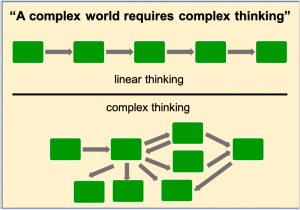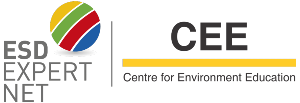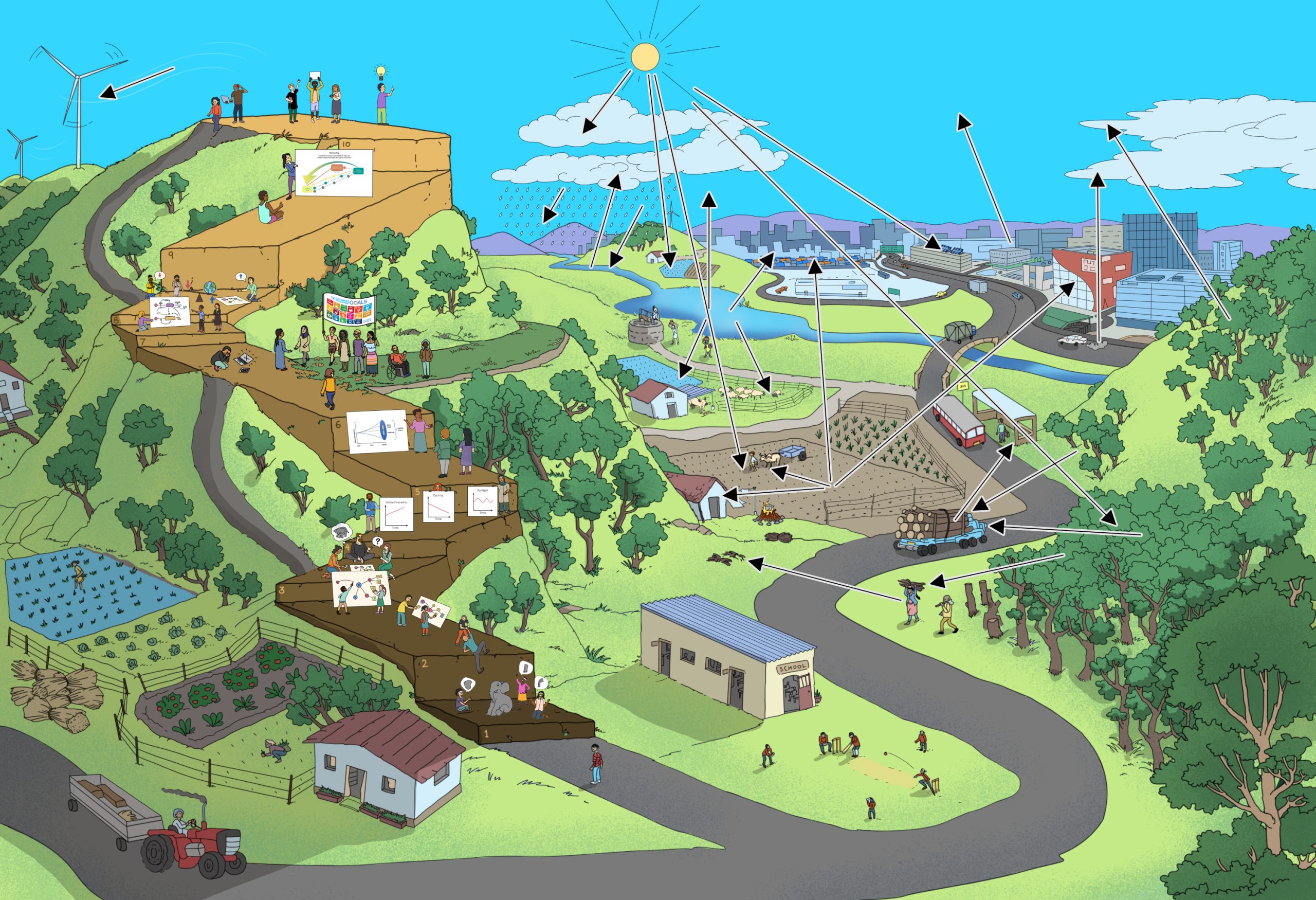Why Systems Thinking Competence
When we have a cup of tea, coffee, or milk; when we get dressed, and when we walk, cycle, drive a car, take a bus to get to a desk, or fieldwork – whatever be our actions, local and global contexts constantly influence our lives. In turn, our behaviour, choices, preferences for different goods and services shape the global context. This intricate connection is the reality for each of us – wherever we are and whether we realize it or not.
The connections exist because the production, trade, movement of goods and products through the supply chain, and consumption of the goods and services we use in our daily lives for our basic needs, wants and well-being are dependent on natural resources such as energy, water, soil, and raw materials.
There are various ways of using natural resources for achieving human well-being. Some production and consumption systems are less resource intensive. Others are a lot more, and lead to severe stress on the natural resources, as well as on human society.
Pollution, water scarcity, soil degradation, loss of biodiversity, and climate change are crucial indicators of the stress on natural resources while poverty, hunger, and displacement reflect a negative impact on human society. These continue to increase with increasing global population and consumption levels.
Degradation of natural habitats has different types of impacts on human beings. These may include diminished productivity of farms, reduced access to nutritious food, livelihoods, and income. They may also be due to the arrangements made (or not made) among people (communities, states, countries), which may lead to conflicts of different kinds. In extreme circumstances conflicts may result in war and violation of human rights.
Human beings also have the ability to avoid degradation and pollution due to human actions! Systems approaches can help
We observe around us a multitude of natural and societal processes like physical settings, landscapes, objects that are both natural and human-made. They include people, their activities, values, cultural practices, and traditional and modern ideas, and rules that influence lives.
The processes are interconnected in a complex web and affect each other. Some processes and connections form subgroups within larger webs with denser interconnections. These complex and dynamic interconnections occur not only at the global but also at the local scale. Interconnections link to individual elements, such as a person or a tree or an individual shop.
The challenges we face are not quite simple linear cause and effect sequences. Multiple factors within the challenges interact in different ways, with reinforcing and or balancing feedback loops.
A reinforcing loop is a situation in which an action produces a result which influences more of the same action thus resulting in growth or decline. For example, in a savings bank account, the principal amount attracts an interest, and that amount is added to the principal using the interest rate. The principal plus the amount added as the interest becomes the new increased principal amount for the next time the interest amount is calculated. In the context of climate change, ice sheets on oceans reflect sunlight reducing the heat absorbed by the earth. However, global warming melts the ice, and the dark ocean is exposed which absorbs more heat. Without the insulating sheet of ice, the ocean also releases more heat into the atmosphere which increases global warming.

A balancing loop on the other hand works towards reaching a set point and maintaining the system at that point. For example, the thermostat in an air conditioner tries to maintain the temperature of the room.
Both balancing and reinforcing loops are present in the systems we are part of. The reinforcing or balancing effect may or may not be seen immediately. The presence of multiple types of feedback may result in unpredictable situations – sometimes taking us by surprise, or manifest as unintended consequences, or even occur as a completely new form of the system.
Therefore, linear thinking is not enough to deal with complexity because it deals with simple cause and effect, or sequential events.
Changes may occur constantly or intermittently, and in the same location or in another location, depending on the system. Consequences may become evident immediately or after several years or even decades after the changes are set in motion. Climate Change is one such example, with impacts that are evident across different time scales, in the present, future, and across different parts of the world and with differing intensity.
All the individual objects and processes on the earth are part of an interconnected whole, which we may call the “earth system”. However, each of these different elements may be part of multiple subsystems at the same time, nested under larger systems. For example,
- The weather system is a part of the climate system. The rain and trees that form part of the weather system of a particular region are part of the local ecosystem.
- Individual classes are a part of the school, and the school is a part of the city it is in, but the school is also part of the Education system of the state or province, or country.
- A house may be part of a neighbourhood, or village or town, while people living in that house may be part of a countrywide community of stamp collectors or amateur radio enthusiasts.
Considering the possibility of interconnections of global-scale processes and the varying time scales of changes in the world, we human beings must develop the methods and skills to understand and work with such complexity. Hence there is a need for developing systems thinking competence.
‘Systems thinking’ is principally a solution-oriented analytical approach. The problems that we perceive in the world may be investigated through a systems exploration. It can lead to a deeper understanding of issues and help reveal the root causes.
In response to the emergence and recognition of global challenges, educators from all over the world continue to develop learning approaches, such as global citizenship education, transformative learning, etc. These approaches are an integral part of Education for Sustainable Development (ESD). ESD seeks to ensure the contribution of education to a cross-societal transformation towards a sustainable world.
ESD is Education for Sustainable Development.
According to UNESCO:
ESD empowers learners to take informed decisions and responsible actions for environmental integrity, economic viability and a just society, for present and future generations, while respecting cultural diversity. It is about lifelong learning, and is an integral part of quality education. ESD is holistic and transformational education which addresses learning content and outcomes, pedagogy and the learning environment. It achieves its purpose by transforming society.
What is ESD
There are different perspectives about sustainability, sustainable development and ESD. For a discussion on these aspects and views, see the paper ‘What is ESD’ by Thomas Hoffmann and Hannes Siege (What is Education for Sustainable Development?)
The SDGs deal with the most significant challenges of our world and were adopted by all United Nations Member States in 2015 as a universal call to action to end poverty, protect the planet and ensure that all people enjoy peace and prosperity by 2030. ESD is also integrated within SDGs.
They include some of the intractable and oldest challenges like poverty and inequality.
SDG 4 on ‘Quality Education’ is the door for Educators to contribute to these internationally agreed goals. Targets are defined for each SDG. In the case of SDG 4, the target relevant for ESD is SDG 4.7, states that:
All learners acquire the knowledge and skills needed to promote sustainable development, including, among others, through education for sustainable development and sustainable lifestyles, human rights, gender equality, promotion of a culture of peace and non-violence, global citizenship, and appreciation of cultural diversity and of culture’s contribution to sustainable development.
For more information on the 17 SDGs and their targets, visit https://sdgs.un.org/goals
It is generally agreed that people ‘need to have certain key competencies that allow them to engage constructively and responsibly with today’s world’ (UNESCO, 2017).
Competencies are specific attributes individuals need for action and self-organization in various complex contexts and situations. They include cognitive, affective, volitional and motivational elements; hence they are an interplay of knowledge, capacities and skills, motives and affective dispositions. Competencies cannot be taught, but have to be developed by the learners themselves. They are acquired during action, on the basis of experience and reflection (UNESCO, 2015; Weinert, 2001).
UNESCO (2017) identifies the following as the key competencies to advance sustainable development:
- Systems thinking competency: the abilities to recognize and understand relationships; to analyse complex systems; to think of how systems are embedded within different domains and different scales; and to deal with uncertainty.
- Anticipatory competency: the abilities to understand and evaluate multiple futures – possible, probable and desirable; to create one’s own visions for the future; to apply the precautionary principle; to assess the consequences of actions; and to deal with risks and changes.
- Normative competency: the abilities to understand and reflect on the norms and values that underlie one’s actions; and to negotiate sustainability values, principles, goals, and targets, in a context of conflicts of interests and trade-offs, uncertain knowledge and contradictions.
- Strategic competency: the abilities to collectively develop and implement innovative actions that further sustainability at the local level and further afield.
- Collaboration competency: the abilities to learn from others; to understand and respect the needs, perspectives and actions of others (empathy); to understand, relate to and be sensitive to others (empathic leadership); to deal with conflicts in a group; and to facilitate collaborative and participatory problem solving.
- Critical thinking competency: the ability to question norms, practices and opinions; to reflect on one’s own values, perceptions and actions; and to take a position in the sustainability discourse.
- Self-awareness competency: the ability to reflect on one’s own role in the local community and (global) society; to continually evaluate and further motivate one’s actions; and to deal with one’s feelings and desires.
- Integrated problem-solving competency: the overarching ability to apply different problem-solving frameworks to complex sustainability problems and develop viable, inclusive and equitable solution options that promote sustainable development, integrating the above mentioned competences.
In this publication, we focus on the first, i.e., ‘Systems thinking competence’, as it is in our view, a core competence.
“Competence” or “Competency”
Both forms are acceptable. In this book, we use “competence”, except in the section above. In the publication referred to, “competency” has been used. We have retained this form in the material quoted from UNESCO (2017).
In this manual, we describe Systems Thinking Competence as follows,
Systems thinking is the ability to describe and/ or visualise a part of a complex reality, express that part of reality as a model, understand the model as a system, use the model to explain the behaviour of the system, anticipate the behaviour of the system, and evaluate its impacts on sustainable development, identify potential points of, and types of interventions, generate options to act, assess their impacts in the frame of sustainable development, and decide whether further actions are necessary or not.
(Based on Frischknecht-Tobler, U., Nagel U., Seyboldt H.(2008))
In order to make it clearer for learning practice:
Systems thinking competence is the
- Ability to describe and/ or visualise a part of a complex reality,
- Express that part of reality as a model,
- Understand the model as a system,
- Use the model to explain the behaviour of the system,
- Anticipate the behaviour of the system,
- Evaluate its impacts on sustainable development,
- Identify potential points of, and
- Types of interventions,
- Generate options to act,
- Assess their impacts in the frame of sustainable development, and decide whether further actions are necessary or not.
In this manual, each of these components of the definition is detailed out as a step with suggested activities and learning methods and two examples.
While we recognize systems thinking as a core competence from among all, we also realize that it is not yet widespread in school curricula and teacher education. With this manual we hope to provide a practice-oriented learning resource that helps learners of the age of 15 years and older (Secondary education level) to develop systems thinking competence. The reason we suggest this age-group is that the cognitive abilities and ability for abstract thinking are likely to have developed to deal with complexity and systems thinking.
We have designed this Systems Thinking resource to also help develop other key competences, as described by UNESCO, to different degrees: anticipatory competence, normative competence, strategic competence, collaboration competence, critical thinking competence, self-awareness competence, and integrated problem-solving competence.
In the subsequent sections, we indicate through illustrations the competences likely to be strengthened in the learning processes presented. This manual is not designed as a standalone resource, but one that draws upon the concepts articulated in the global discourse on ESD, and which offers practical steps to develop systems thinking. In this context, the educator, whether a teacher or a community or youth group facilitator, has a key role in bringing the concepts of ESD into practice.
 |
Goal 1: End poverty in all its forms everywhere. |  |
Goal 9: Build resilient infrastructure, promote inclusive and sustainable industrialization and foster innovation. |
 |
Goal 2: End hunger, achieve food security and improved nutrition and promote sustainable agriculture. |  |
Goal 10: Reduce inequality within and among countries. |
 |
Goal 3: Ensure healthy lives and promote well-being for all at all ages. |  |
Goal 11: Make cities and human settlements inclusive, safe, resilient and sustainable. |
 |
Goal 4: Ensure inclusive and equitable quality education and promote lifelong learning opportunities for all. |  |
Goal 12: Ensure sustainable consumption and production patterns. |
 |
Goal 5: Achieve gender equality and empower all women and girls. |  |
Goal 13: Take urgent action to combat climate change and its impacts. |
 |
Goal 6: Ensure availability and sustainable management of water and sanitation for all. |  |
Goal 14: Conserve and sustainably use the oceans, seas and marine resources for sustainable development. |
 |
Goal 7: Ensure access to affordable, reliable, sustainable and modern energy for all |  |
Goal 15: Protect, restore and promote sustainable use of terrestrial ecosystems, sustainably manage forests, combat desertification, and halt and reverse land degradation and halt biodiversity loss. |
 |
Goal 8: Promote sustained, inclusive and sustainable economic growth, full and productive employment and decent work for all. |  |
Goal 16: Promote peaceful and inclusive societies for sustainable development, provide access to justice for all and build effective, accountable and inclusive institutions at all levels. |
 |
Goal 17: Strengthen the means of implementation and revitalize the global partnership for sustainable development. |

